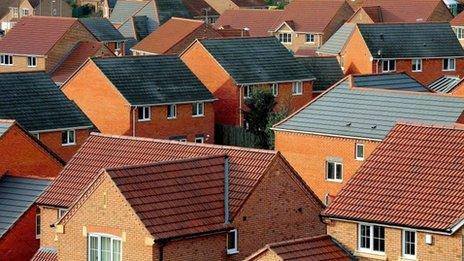The UK's traditional recovery
- Published
- comments

Growth has been driven by activity related to the revival in the housing market
Hooray hooray hooray.
It is a recovery Jim, and precisely as we know it.
In other words - as the governor of the Bank of England has pointed out - it has been driven by household consumption and activity related to the revival in the housing market.
And although most would say that after the long years of contraction and stagnation since the crash, any recovery will do, we cannot yet bank on the durability of this one.
What we don't yet have is what the coalition government insisted it wanted and it would deliver, namely a balanced recovery whose longevity is assured.
Not out of the woods yet
What's missing?
Well, business investment remains low, though there is glimmer of recovery.
And the deficit in trade and on the current account remain worryingly large.
Fat chance of reducing the massive burden of debt bearing down on the UK economy - 500ish per cent of national income and rising - until we start to pay our way in the world, by selling more overseas than we buy.
Looking on the brightside
All that said, most will - understandably - want to seize on the positive from these latest statistics.
And in these latest GDP or national output figures there are pegs on which to hang hope.
We have now had four unbroken quarters of growth, the best performance since the third quarter of 2010. And a fifth quarter of growth is certainly in the bag, barring a calamity totally out of left field.
In fact, more-or-less every forecaster on the planet believes that the UK economy in 2014 will grow somewhere between 2.4% (the view of the downbeat Office for Budget Responsibility) and 3.2% (the optimism of bullish US bank, Citigroup) - which would be an acceleration from 2013's 1.9% growth.
And to put that into context, in the boom years, between 1992 and 2008, annual growth was around 3%.
The UK's getting richer
So the country is getting richer again, although at a slower rate than we used to regard as normal. And the size of the economy is still 1.3% below where it was six years ago.
Also, although spending by consumers has driven the recovery, manufacturing is apparently on the up: it grew 0.9% in the last three months of the year.
But manufacturing is a very small proportion - around a tenth - of the economy.
So although there are signs of a serious manufacturing recovery, the enormous service sector - which provides more than three quarters of our national output or GDP - contributed six sevenths of the entire 0.7% increase in GDP.
Unbalanced recovery
And if you think balance means that the manufacturing sector should grow bigger than the service sector, that has not happened since the crash.
Output from the service sector is now 1.3% greater than it was at the previous peak in the first three months of 2008, while production output is a significant 12% below where it was then (and that wasn't even the recent peak of production output).
That said, lots of services are exported. We should not denigrate them. They are vital to our prospects.
But historically the most successful exporter of services in the UK has been the City of London. And the recent carnage in the banking part of the City means its trading performance has been impaired relative to its main rivals, notably Wall Street.
And what do all these numbers and blather actually mean for you and me?
Well inflation is falling, and employers are beginning to talk about being more confident about the outlook and about a modest tightening in the labour market, or a greater challenge to find the right staff.
So just maybe - whisper it very quietly indeed - come the end of the year a majority of us will begin to feel the benefits of the recovery in our pockets, in living standards that may start to rise again.
Hooray hooray hooray.